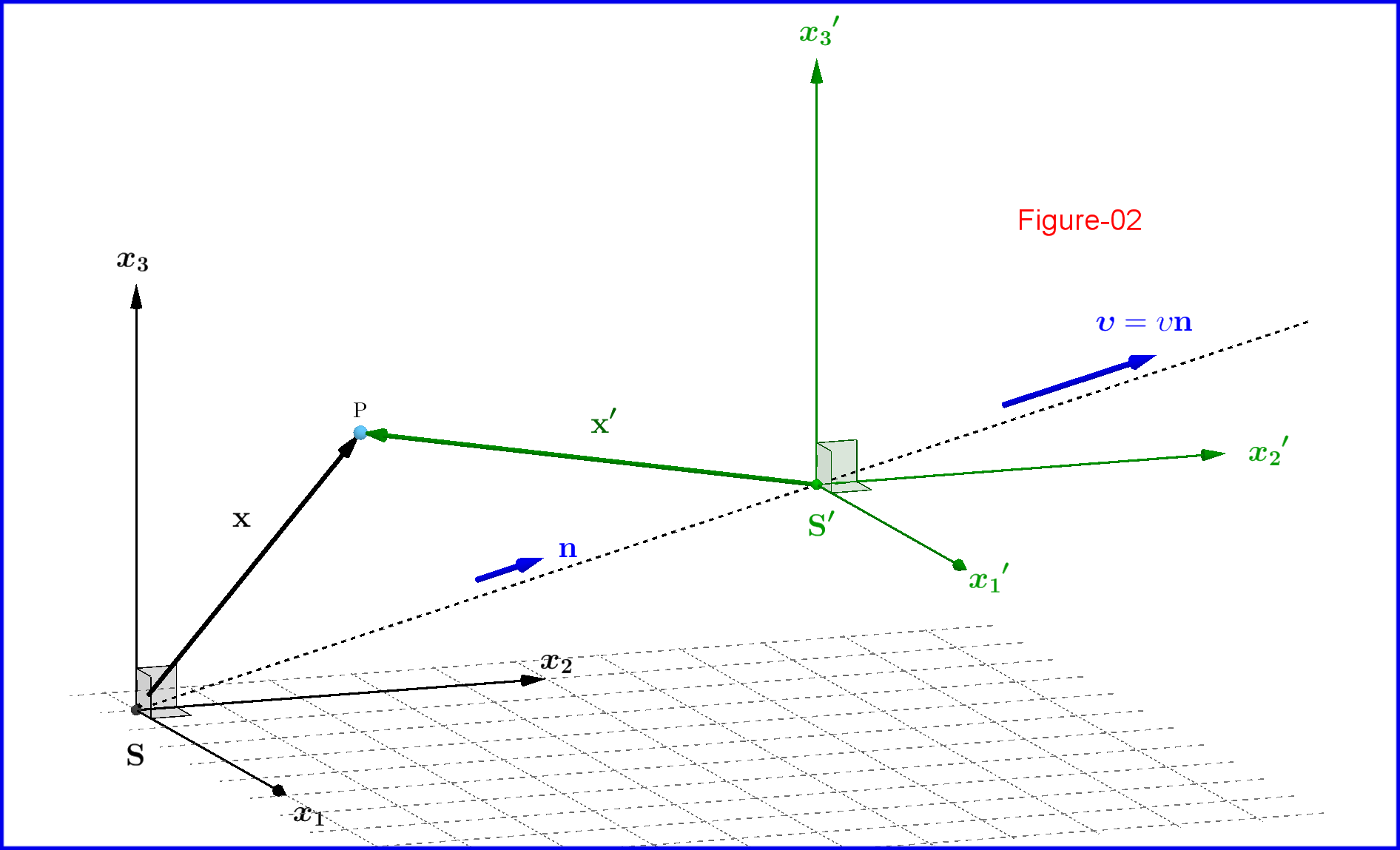I am trying to derive the source four velocity for Lorentz boosted frame. If the source four velocity for rest frame is denoted as $U^{\alpha} = (1, \bar 0)$, then how do I write this $U^{\alpha}$ for a Lorentz boosted frame? Also could you please provide a good explanation why we write the four velocity as $(1, \bar 0)$? A good derivation for the boosted frame will also be very helpful for me.
1 Answer
The velocity 4-vector is \begin{equation} \mathbf{U}=\left(\gamma\, c, \gamma\, \mathbf{u}\right) \quad\text{where}\quad \gamma=\left(1-\dfrac{u^2}{c^2}\right)^{\bf -\frac12} \tag{01}\label{eq01} \end{equation} and $\:\mathbf{u}\:$ the velocity 3-vector.
In the rest frame of the particle $\:\mathbf{u}=\boldsymbol{0}\:$ and $\:\gamma=1\:$ so (for $\:c=1\:$) \begin{equation} \mathbf{U}_0=\left(1, \boldsymbol{0}\right) \tag{02}\label{eq02} \end{equation} Obviously $\:\bar 0\:$ is the symbol for the null 3-vector $\:\boldsymbol{0}\:$ and I think that $\:\bar u\:$ would be for the 3-vector $\:\mathbf{u}\:$ in general.
Now, in above Figure-02 an inertial system $\:\mathrm S'\:$ is translated with respect to the inertial system $\:\mathrm S\:$ with constant velocity
\begin{equation}
\boldsymbol{\upsilon}=\left(\upsilon_{1},\upsilon_{2},\upsilon_{3}\right)=\left(\upsilon \mathrm n_{1},\upsilon \mathrm n_{2},\upsilon \mathrm n_{3}\right)=\upsilon \mathbf n\,, \qquad \upsilon \in \left(-c,c\right)
\tag{03}\label{eq03}
\end{equation}
The Lorentz transformation is
\begin{align}
\mathbf{x}^{\boldsymbol{\prime}} & = \mathbf{x}+(\gamma-1)(\mathbf{n}\boldsymbol{\cdot} \mathbf{x})\mathbf{n}-\gamma \boldsymbol{\upsilon}t
\tag{04a}\label{eq04a}\\
t^{\boldsymbol{\prime}} & = \gamma\left(t-\dfrac{\boldsymbol{\upsilon}\boldsymbol{\cdot} \mathbf{x}}{c^{2}}\right)
\tag{04b}\label{eq04b}
\end{align}
in differential form
\begin{align}
\mathrm d\mathbf{x}^{\boldsymbol{\prime}} & = \mathrm d\mathbf{x}+(\gamma-1)(\mathbf{n}\boldsymbol{\cdot} \mathrm d\mathbf{x})\mathbf{n}-\gamma\boldsymbol{\upsilon}\mathrm dt
\tag{05a}\label{eq05a}\\
\mathrm d t^{\boldsymbol{\prime}} & = \gamma\left(\mathrm d t-\dfrac{\boldsymbol{\upsilon}\boldsymbol{\cdot} \mathrm d\mathbf{x}}{c^{2}}\right)
\tag{05b}\label{eq05b}
\end{align}
and in matrix form
\begin{equation}
\mathbf{X}^{\boldsymbol{\prime}}=
\begin{bmatrix}
\mathbf{x}^{\boldsymbol{\prime}}\vphantom{\dfrac{\gamma\boldsymbol{\upsilon}^{\boldsymbol{\top}}}{c}}\\
c t^{\boldsymbol{\prime}}\vphantom{\dfrac{\gamma\boldsymbol{\upsilon}^{\boldsymbol{\top}}}{c}}
\end{bmatrix}
=
\begin{bmatrix}
\mathrm I+(\gamma-1)\mathbf{n}\mathbf{n}^{\boldsymbol{\top}} & -\dfrac{\gamma\boldsymbol{\upsilon}}{c} \vphantom{\dfrac{\gamma\boldsymbol{\upsilon}^{\boldsymbol{\top}}}{c}}\\
-\dfrac{\gamma\boldsymbol{\upsilon}^{\boldsymbol{\top}}}{c} & \hphantom{-}\gamma
\end{bmatrix}
\begin{bmatrix}
\mathbf{x}\vphantom{\dfrac{\gamma\boldsymbol{\upsilon}^{\boldsymbol{\top}}}{c}}\\
c t\vphantom{\dfrac{\gamma\boldsymbol{\upsilon}^{\boldsymbol{\top}}}{c}}
\end{bmatrix}
=\mathrm L\mathbf{X}
\tag{06}\label{eq06}
\end{equation}
where $\:\mathrm L\:$ the real symmetric $\:4\times 4\:$ matrix
\begin{equation}
\mathrm L \equiv
\begin{bmatrix}
\mathrm I+(\gamma-1)\mathbf{n}\mathbf{n}^{\boldsymbol{\top}} & -\dfrac{\gamma\boldsymbol{\upsilon}}{c} \vphantom{\dfrac{\gamma\boldsymbol{\upsilon}^{\boldsymbol{\top}}}{c}}\\
-\dfrac{\gamma\boldsymbol{\upsilon}^{\boldsymbol{\top}}}{c} & \hphantom{-}\gamma
\end{bmatrix}
\tag{07}\label{eq07}
\end{equation}
and
\begin{equation}
\mathbf{n}\mathbf{n}^{\boldsymbol{\top}} =
\begin{bmatrix}
\mathrm n_{1}\vphantom{\dfrac{}{}}\\
\mathrm n_{2}\vphantom{\dfrac{}{}}\\
\mathrm n_{3}\vphantom{\dfrac{}{}}
\end{bmatrix}
\begin{bmatrix}
\mathrm n_{1} & \mathrm n_{2} &
\mathrm n_{3}\vphantom{\frac12}
\end{bmatrix}
=
\begin{bmatrix}
\mathrm n_{1}^{2} & \mathrm n_{1}\mathrm n_{2} & \mathrm n_{1}\mathrm n_{3}\vphantom{\dfrac{}{}}\\
\mathrm n_{2}\mathrm n_{1} & \mathrm n_{2}^{2} & \mathrm n_{2}\mathrm n_{3}\vphantom{\dfrac{}{}}\\
\mathrm n_{3}\mathrm n_{1} & \mathrm n_{3}\mathrm n_{2} & \mathrm n_{3}^{2}\vphantom{\dfrac{}{}}
\end{bmatrix}
\tag{08}\label{eq08}
\end{equation}
a matrix representing the vectorial projection on the direction $\:\mathbf{n}$.
The velocity 3-vector $\:\mathbf{u}\:$ of a particle is transformed as follows \begin{equation} \mathbf{u}^{\boldsymbol{\prime}} = \dfrac{\mathbf{u}+(\gamma-1)(\mathbf{n}\boldsymbol{\cdot} \mathbf{u})\mathbf{n}-\gamma \boldsymbol{\upsilon}}{\gamma \left(1-\dfrac{\boldsymbol{\upsilon}\boldsymbol{\cdot} \mathbf{u}\vphantom{\frac12}}{c^{2}}\right)} \tag{09}\label{eq09} \end{equation} equation proved by dividing equations \eqref{eq05a}, \eqref{eq05b} side by side and setting $\:\mathbf{u}\equiv \mathrm d\mathbf{x}/\mathrm d t\:$, $\:\mathbf{u'}\equiv \mathrm d\mathbf{x'}/\mathrm d t'$.
Hint :
Using above equations and especially \eqref{eq09} try to define a 4-dimensional quantity $\:\mathbf{U}\:$ that would be a (Lorentz) 4-vector and would be used as the velocity 4-vector.
Related : Lorentz transformation of velocity 4-vector.
-
$\begingroup$ @Forbenius i have this result $\frac{\gamma-1}{u^2}\vec{u}\,\vec{u}^T$ is that same what you got? $\endgroup$– EliCommented Sep 20, 2018 at 6:54
-
$\begingroup$ @Eli, Precisely : My unit vector $\;\mathbf{n}\;$ is identical to your unit vector$\;\vec{u}/u$. $\endgroup$– VoulkosCommented Sep 20, 2018 at 6:58

